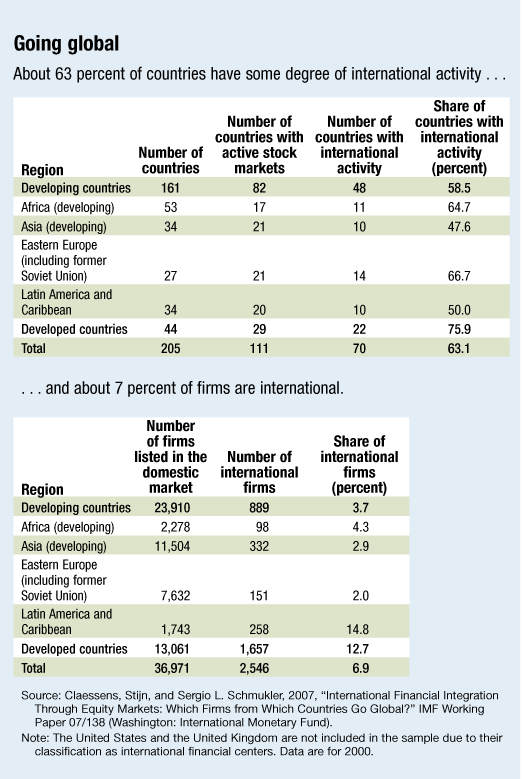
Typical street scene in Santa Ana, El Salvador. (Photo: iStock)
IMF Survey: IMF Study Tracks Which Firms Go Global
April 17, 2008
- Global financial integration surges to record levels in the last few years
- But relatively few firms and countries make use of world financial markets
- Firms that do are larger and fast-growing and from larger, open economies
Firms that raise money from overseas capital markets tend to be from larger countries with more open economies and better policies but with worse institutional conditions, according to an IMF study.

A worker assembles mobile phones in Kamp-Lintfort, Germany; firms from larger, more open economies actively participate in international capital markets (photo: Siemens AG/Getty)
Financial Integration
The study finds that financial integration has increased substantially but the benefits are widely shared by all firms.
The financial market integration of recent years has taken the form of increased cross-border capital flows, tighter links among financial markets, and a greater presence of foreign financial firms around the world. Many of the standard measures of financial globalization—such as gross capital flows and stocks of foreign assets and liabilities—offer insights on an aggregate basis.
But, according to a recent IMF Working Paper, they provide less evidence on how extensive financial integration is, how deep it reaches, and how it comes about. Specifically, these measures do not tell how many firms from how many countries actively participate in major world stock exchanges, what proportion of corporations internationalize, or, most important, why firms internationalize.
This paper uses a large dataset (of 39,517 firms from 111 countries covering the period 1989-2000) to study the extent of international financial integration by looking at firms' participation in global equity markets. Some 2,500 firms of the 39,000+ firms in the sample are international, about 7 percent on average—with a high of 15 percent for Latin America, followed by 12.7 percent for developed countries and a low of 2 percent for Central and Eastern Europe. Altogether about 63 percent of countries have some degree of internationalization by their firms accessing international equity markets, with the share of countries with international activity the greatest for advanced countries at 76 percent (see table).
This data allows the authors to answer such questions as which country and firm characteristics help or hinder integration with global financial markets.

Which country attributes are important?
While experts agree that domestic stock market development is strongly linked with country (macroeconomic) influences—such as GDP, inflation, and trade openness—these variables also relate to firms' activity in global equity markets in several ways.
One view holds that worse domestic macroeconomic conditions increase the need and desire of firms to tap international markets. Poor domestic markets have long been considered a key reason for capital flight and for greater use by all types of domestic residents and firms of international capital markets. Furthermore, global equity markets offer firms from countries with weak institutional frameworks and lower levels of law and order the ability to "bond" to systems that better protect investor rights.
Another view holds that better domestic environments can increase the attractiveness of firms to investors, especially foreign ones. Investors able to invest globally will generally offer larger amounts of external financing and lower cost as firms' host country fundamentals improve. Thus, better domestic fundamentals lead to more use of international capital markets under this view.
In an empirical analysis, it is hard to pin down the relative importance of these two views—that is, the relative role of demand- and supply-side factors that make (and allow) corporations to use global capital markets. But the study confirms that firms in countries with larger economies, higher income levels, greater trade and financial openness, and better macroeconomic fundamentals—but worse institutional environments—tend to use global equity markets more.
Which firm characteristics are important?
Firms have many incentives to tap global markets, including lower cost of capital and better terms, access to wider investor bases, and the potential for more liquid securities. But while most studies find that internationalization yields some benefits for firms, analysis of which firm characteristics matter for internationalization has been sparser.
The study shows that firms that tap international financial markets tend to be larger, grow faster, enjoy higher rates of return, and have more foreign sales. Firm size seems to be the most important determinant. For example, a 1 percent increase in total assets would raise the probability of becoming international by about 1.4 percentage points. And a 1 percent increase in foreign sales growth would boost the probability of going abroad by 0.8 percentage points. Firm size likely plays a key role because of the substantial fixed costs involved in accessing international markets.
Firms with large, unrealized growth opportunities may also be more likely to use more developed global markets. And since firms with foreign sales can pledge foreign revenues as a form of international collateral, they may be able to borrow more in global markets.
Conclusion
Internationalization is not evenly spread across countries. The relatively few firms that internationalize tend to be larger, faster growing, and to have foreign sales and are based in larger, higher-income, and open economies. The study thus suggests that it might be difficult for many firms to participate directly in international capital markets and that international financial integration may remain limited to a small group of firms and countries.
This article is based on IMF Working Paper 07/138, "International Financial Integration Through Equity Markets: Which Firms and Which Countries Go Global?" by Stijn Claessens and Sergio L. Schmukler. The paper is also available at the Journal of International Money and Finance, Vol. 26, Issue 5, September 2007, pp. 788-813.
Comments on this article should be sent to imfsurvey@imf.org


